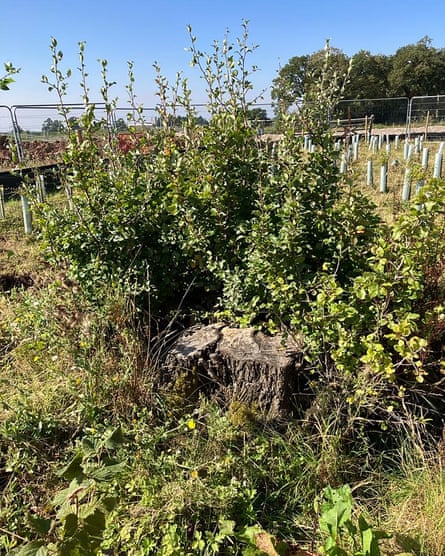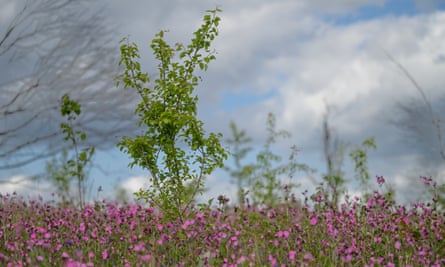The previous winner of the “Tree of the Year” award has been cut down to make space for HS2. However, it is thriving once again as it regrows from its transplanted stump.
The pear tree, located in Cubbington, Warwickshire, has been estimated to be over 250 years old. Recently, it gained attention when it was at risk of being cut down. Despite receiving the Tree of the Year award in 2015 and garnering thousands of signatures on a petition to protect it, the tree was ultimately chopped down in 2020 by HS2 contractors.
There was concern that efforts to preserve the beloved tree, which grows in a hedge near an old forest and is believed to be the second oldest pear tree in Britain, would be unsuccessful due to its hollow trunk.
However, much to the joy of residents, the stump and root ball were relocated by contractors and now sits in a field 100 meters away from its original spot. Despite the move, it is thriving with new growth and foliage.
Rosemary Guiot, a resident of Cubbington village, expressed her surprise and joy, but acknowledged that things will never be as they were before.

The locals believe that the stump is growing back because it was lucky enough to be planted in dense clay soils that remained damp during the past dry summers. The lack of moisture has caused the death of numerous young trees that were planted by HS2 contractors in an attempt to offset the damage caused by cutting through the historic South Cubbington Wood.
Amy Middlemist, the head of landscaping at Balfour Beatty Vinci, expressed excitement at the fact that the Cubbington pear tree is still thriving in its new home, which is now part of HS2’s growing habitats for wildlife. This regrowth is a result of the tree’s root system storing energy from photosynthesis and using it for new growth, thanks to the proper amount of nutrients.
Although residents and conservationists had requested a tunnel to be built beneath the pear and South Cubbington Wood, the high-speed railway has been constructed through the historic woodland. To compensate for the loss of 2 hectares of ancient trees, HS2 has planted 60,000 new trees on 17 hectares of land surrounding the wood. Additionally, 6 hectares of broadleaved trees have been planted to connect the wood to the River Leam corridor.
Middlemist stated that they are currently working on the landscape and habitat creation program for HS2 in this region. This includes constructing two green bridges that will restore access to public footpaths and connect wildlife corridors.

The Cubbington pear continues to thrive within the village of Cubbington, thanks to the efforts of community members who sought help from a skilled grafting specialist to preserve this historic fruit.
The community members collected branches from the tree before it was cut down. Horticulturist Paul Labous from Shuttleworth agricultural college skillfully grafted the branches onto new roots, resulting in 15 new trees being given back to the community.
The pear’s descendants have been placed in the churchyard, two primary schools, and various nature reserves and parks.
HS2 has utilized Labous’s approach and enlisted a private nursery to generate an additional 40 young trees, which have subsequently been planted in the designated location.
However, the fact that the original tree has survived is a pleasant surprise for the local community.
The original pear tree was not created through grafting like most fruit trees. Therefore, in the future, the new shoots from its base should yield the same type of pears as the old tree did. Guiot notes that these pears may not be considered gourmet, but they are still enjoyable to eat.
Even though HS2 highlights the achievement of one of its contentious environmental actions, the people of Cubbington view the pear’s survival as a symbol of nature’s resilience.
Guiot stated that it was a form of defiance towards HS2, similar to showing two fingers.
Source: theguardian.com















